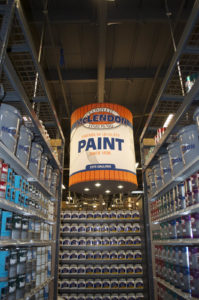
More technology
There are two main parameters that shops look at when they’re investing in printers: print quality and speed. Both have been improving markedly. In recent months, Rainier Industries has been upgrading to Durst Rhotex’s P10/P12 series of direct-to-fabric printers. Scott Powell, marketing director, is a fan of the new tech.
“The P stands for picoliter,” he explains. “A picoliter [one trillionth of a liter] expresses drop size. They keep engineering that dot size down and the speed up, and not only are we getting a better looking image, but we’ve got a faster printer, so that makes you more competitive both on turnaround time and the ability to put the bigger jobs through at a price point where you can make some money.”
Lily Hunter, product manager, textiles and consumables, at large-format printer manufacturer Roland DGA Corp., echoes the sentiment that speed is key.
“We’re constantly innovating to offer our users advanced printers that deliver better image quality and detail, wider color gamut and increased productivity,” she says. “Our new Texart RT-640 dye-sublimation printer, for example… delivers rich, vibrant sublimated graphics at speeds of up to 351 square feet per hour. [It also] allows the printer to automatically switch to a new ink pouch when the original runs out.”
Until recently, one of the limitations with latex printing was that double-sided images had to be created manually on large-format printers. But Dan Dix, business manager for digital media at Herculite Products Inc., says there’s a software option called OMAS (Optical Media Advanced Sensor) on HP’s new latex printers that automates the process. “It’s cool, it has great ink, and I think you will start to see this used more and more as customers who buy these printers realize what they have,” he says.
Until recently, one of the limitations with latex printing was that double-sided images had to be created manually on large-format printers.
Lower prices
Powell says the cost of flexible-substrate printers continues to drive downward as manufacturers seek new customers. It’s possible to spend more than half a million bucks—as Rainier just did on its newest direct-to-fabric printer—or it’s possible to get in for less than a tenth of that. You still get a nice-looking image, but you’ll lose some bells and whistles and the images won’t print as fast. A less expensive printer may limit a shop’s throughput, but it at least gives fabricators the capability of printing their own images.
Hunter says the cost of entry into the market varies depending on the specific market and application, and every company has to decide whether it wants to pay that cost or farm the work out.
“Purchasing equipment for apparel and dye-sublimation applications will require a higher initial investment than getting set up for eco-solvent or UV printing,” she says. “There’s a higher learning curve with dye sublimation for apparel, so additional training will also be required. Entry-level dye-sublimation equipment purchases can total $50,000 or more (leasing the equipment would cost something like $1,200 a month), so make sure this kind of investment makes sense from an ROI standpoint. You’ll need to take into consideration your expected revenue and profits, or if you’re a company bringing graphics in-house, the amount you’ll save by not outsourcing.”
On the bright side, she says, by printing their own graphics in-house, companies can develop prototypes for review and make any needed adjustments quickly and easily. They also become less dependent on other companies’ abilities, resources and time schedules; they can control the quality and turnaround of their work. The question is whether the volume justifies the cost.
Eric Tischer, president of Verseidag seemee US Inc., a manufacturer and distributor of substrates, says there are two sides to the equation.
“The clear benefit of companies printing and fabricating their own graphics is that they keep their work in-house and have full control of QC and costs,” he points out. “This typically also streamlines the process for printers who understand the strengths and or limitations of their design capabilities, print outputs, finishing equipment and fabrication. On the other hand, sourcing graphics provides many companies the opportunity to offer products and solutions that they can’t produce in-house. This clearly lowers overhead and allows companies to play in market segments that their in-house production isn’t set up for.”
It’s not just equipment, Brian Hite, president of Image Options, says; it’s expertise and staffing as well. Fabricators will understand the properties of fabrics and be able to sew more exactly than printing specialists; but they will be at a disadvantage when it comes to the technical side of printing.
“The learning curve is fairly steep,” he says. “[There are] things like color profiling devices, software to write the profiles so that the colors that you intend to put on the fabric are actually what you output. And then there’s the knowledge of printing the files. You’ll need a skilled prepress operator who can actually use the applications that are used for design and for production of the artwork. All of those things, they add up. It’s not just a simple, sit down at a desk and hit ‘print’ on your computer. There’s a lot more to it than that.”
Companies looking to enter the fabric graphics industry often fare best by finding a good outsourced provider and building the demand among their clientele. Once that demand is in place, they can think about investing in equipment.
“We’ve had numerous clients that have done that over the years, where we printed all of their fabric and their graphics, and gradually as they built more and more demand, they went out and bought their own equipment and started doing the work in-house,” Hite says.
 TEXTILES.ORG
TEXTILES.ORG


